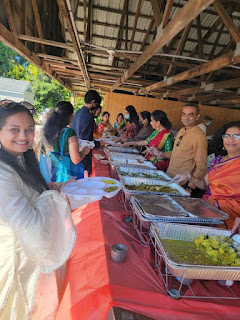( CTMM वार्ताहर कोलचेस्टर कनेक्टिकट USA )
काल इथे झालेल्या CTMM गणपती उत्सवाच्या कार्यक्रमात उपस्थित प्रेक्षकांची हसून हसून पोटे दुखली. एक सोडून तीन धम्माल विनोदी प्रवेशांनी प्रेक्षकांना इतके हसवले की EC ने त्यांना लोळायला गाद्या ठेवल्या पाहिजे होत्या असे मत काहींनी व्यक्त केले. २४ तास उलटले तरी काही प्रेक्षकांना आठवून आठवून हसू येत राहिले. ह्या परिस्थितीस EC ला जबाबदार का ठेवू नये असे मत काही उपस्थित कायदे तज्ज्ञ मंडळींनी व्यक्त केले
हसण्या च्या हॅट्रिक मध्ये पहिला प्रवेश होता अमेय टुमणे , वर्षा देशमुख, जोत्स्ना कुरकुटे आणि अनुप्रिया कायंदे यांचा. ST प्रवासात इरसाल मायलेकी स्वतःकरिता एक डबल सीट एका reserved प्रवास करणाऱ्या होतकरू युवकाकढून कसे लांबवतात असे नाट्य होते. आई चे काम केलेल्या जोत्स्ना यांनी त्यांच्या गावरान साजावरून आणि ग्रामीण मॉडर्न मुली चे काम करणाऱ्या वर्षा यांने धमाल आणली . अमेय वर खरंच दया आली शेवटी. अनुप्रिया चा शेवटचा टच कभी हा कभी ना टाईप होता. अमेय चे direction अप्रतिम.
दुसरा प्रवेश सचिन कुलकर्णी यांच्या पुरुष आणि स्त्रियांना मध्ये क्रिकेट मॅच चा होता. छोट्या जागेत खूप लोकांनी समाविष्ट असलेल्या स्कीट मध्ये खूप धमाल आली . बेवडा मारून तर्रर्र होईन भेभान डान्स करणारा PP (नितीश पंडित ), साडी घालून बॅटिंग करणाऱ्या काकू(आसावरी नारकर ), cheer लीडर( वैभवी पंडित) , घुंघट घालून मॅच खेळणारी ठेलेवाली मौशी ( पल्लवी राजे), जेन्टस कॅप्टन महेंद्र जोग आणि खेळाडू ( शिल्पा कुलकर्णी,आशिष दळवी) यांनी क्रिकेट किती वेगळ्या पद्धतीने खेळता येते याचे प्रात्यक्षिक दिले. त्यांनी world कप मध्ये टीम इंडिया ला टिप्स द्याव्यात असे क्रिकेट फॅन्स म्हणतात . सचिन कुलकर्णी यांनी हेल्पलेस अंपायर चे काम करत असताना डायरेक्शन करताना किती मेहनत घ्यावी लागली असेल?
तिसरा शो मध्ये कहानी घर घर की पेश केली . नवरा बायको (किरण-वैदेही परांजपे)मधले कायम उडणारे खटके आणि येणारा इरसाल मित्र (मुकुंद औटी ) त्यामध्ये तेल ओतून खूप आग लावतो. प्रेक्षक इतके इमोशनली गुंतले की नवरे आणि बायका मंडळी रेस्पेक्टिव्हली sympathize करायला लागली . शेवटी दिपाली औटी यांनी कहर केला आणि मित्राला (मुकुंदाला )जमिनीवर आणले. बहुतेक आता कनेक्टिकट मध्ये मुकुंद ची(कु) प्रसिद्धी दूर -दूर पर्यंत पोहोचली . वैदेही यांनी खूप अप्रतिम दिग्दर्शन केले
ह्या तिन्ही प्रवेशांनां जोडणारा असा टॉक शो गौतम नाईक यांनी लिहिला होता. प्रसिद्ध राजकारणी स्त्री नेता (माधवी कानेटकर) यांची खुमासदार आणि धमाल शैलीत मुलाखत नाईक यांनी घेतली आणि वरील प्रसंग गुंफले . प्रेक्षकांना त्यांनी अजून हसण्या चा बुस्टर डोस दिला आणि मंडळी पुढील काही महिन्यांसाठी कंटाळ्यापासून सुरक्षित केली.
तसे बघायला गेले तर हास्ययात्रा हा CTMM गणपती हॅट्रिक सेलेब्रेशन चा तिसरा भाग. प्रथम लोकांनी गणपती मिरवणुकीत ढोल ताश्यांवर भरभरून लेझीम व डान्स केला. नंतर CTMM १५-२० सुग्रणींनी केलेल्या घरगुती, शास्त्रोक्त स्वयंपाकावर यथेच्च ताव मारला. घरी २०० लोकांची स्वयंपाक स्वयंसेवकानीं करणे असे काही अमेरिकेत होऊ शकते ह्यावर खूप जणांचा विश्वासच नव्हता . पण हौसेला मोल नाही. १९८२ पासून हि प्रथा आहे . त्यावर हॅट्रिक केली हास्ययात्रे ने. गणपती पूजा , आरती, मुलांनी म्हणलेले अथर्वशीर्ष पण छान झाले. अनुप्रिया कायंदे , अंजली साठे, अश्विनी जोशी आणि ग्रुप मधील मुलांनी छान गणपतीची गाणी आणि भजने म्हणाली. CTMM मराठी शाळेतील कोरगावकर दाम्पत्याचा सत्कार झाला. गणपतीचे डेकोरेशन , सभागृह , ध्वनी , पूजा सगळ्याचे आयोजन अविरत काम करत EC मधील राधिका परमानंद, किरण परांजपे, वैभवी पंडित, वृषाली सालोडकर, माधवी कानेटकर, सिद्धार्थ पेंढारकर आणि वृत्त निवेदक गौतम नाईक यांनी केले.











